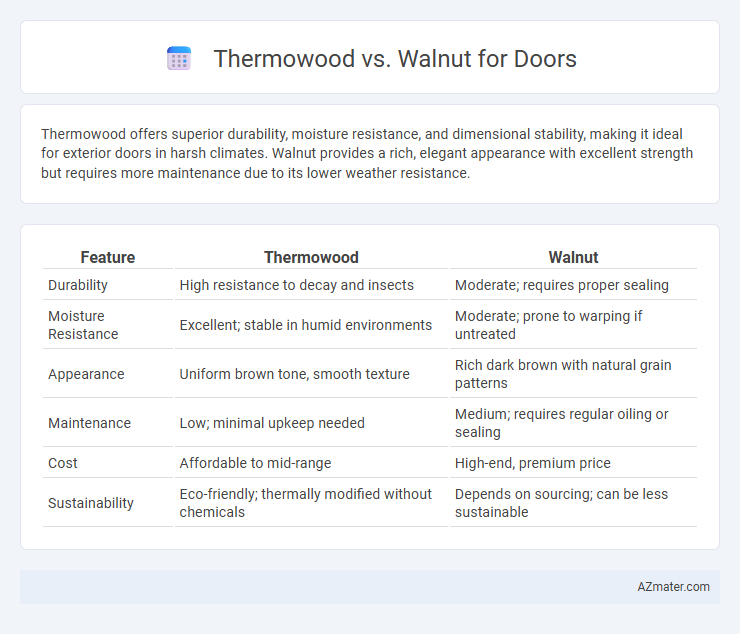Thermowood offers superior durability, moisture resistance, and dimensional stability, making it ideal for exterior doors in harsh climates. Walnut provides a rich, elegant appearance with excellent strength but requires more maintenance due to its lower weather resistance.
Table of Comparison
| Feature | Thermowood | Walnut |
|---|---|---|
| Durability | High resistance to decay and insects | Moderate; requires proper sealing |
| Moisture Resistance | Excellent; stable in humid environments | Moderate; prone to warping if untreated |
| Appearance | Uniform brown tone, smooth texture | Rich dark brown with natural grain patterns |
| Maintenance | Low; minimal upkeep needed | Medium; requires regular oiling or sealing |
| Cost | Affordable to mid-range | High-end, premium price |
| Sustainability | Eco-friendly; thermally modified without chemicals | Depends on sourcing; can be less sustainable |
Thermowood vs Walnut: An Overview
Thermowood offers enhanced durability and resistance to moisture due to its heat-treatment process, making it ideal for exterior doors exposed to varying weather conditions. Walnut provides a rich, dark aesthetic with natural grain patterns, favored for interior doors where appearance is prioritized over extreme weather resistance. The choice between Thermowood and Walnut hinges on balancing performance needs, with Thermowood excelling in longevity and stability, while Walnut delivers premium visual appeal.
Aesthetic Differences Between Thermowood and Walnut Doors
Thermowood doors exhibit a rich, uniform brown hue with subtle natural grain patterns enhanced by the wood's heat treatment, providing a modern and durable finish. Walnut doors are prized for their deep, dark chocolate tones and intricate, swirling grain patterns that add a luxurious and classic appeal to interiors. The warm, rustic look of Thermowood contrasts with the elegant sophistication of Walnut, allowing homeowners to choose between contemporary minimalism and timeless richness.
Durability and Longevity Comparison
Thermowood offers exceptional durability due to its heat-treated process, making it highly resistant to rot, insects, and moisture, which significantly extends its lifespan in outdoor applications. Walnut, while prized for its rich aesthetic and solid hardwood properties, tends to be more susceptible to environmental wear and requires regular maintenance to prevent warping and decay. Choosing Thermowood ensures superior longevity and minimal upkeep for door installations exposed to harsh weather conditions compared to the natural but less weather-resistant walnut wood.
Weather Resistance and Stability
Thermowood offers superior weather resistance due to its heat-treated process, which reduces moisture absorption and enhances dimensional stability, making it ideal for outdoor doors exposed to harsh climates. Walnut, while prized for its rich appearance and durability, is less resistant to moisture fluctuations and can warp or swell under prolonged exposure to wet conditions. Choosing Thermowood over Walnut for doors ensures better long-term stability and protection against weather-related damage.
Maintenance Requirements
Thermowood doors require minimal maintenance due to their heat-treated wood structure, which enhances durability and resistance to decay, reducing the need for frequent sealing or refinishing. Walnut doors, although prized for their rich color and grain, demand regular upkeep including periodic polishing and sealing to prevent moisture damage and maintain their aesthetic appeal. Choosing Thermowood for doors ensures long-term performance with lower maintenance efforts compared to the more delicate care regimen of walnut.
Environmental Impact and Sustainability
Thermowood, produced through a controlled heat treatment process, is environmentally friendly due to its use of sustainably sourced softwoods and the absence of chemical preservatives, resulting in a lower carbon footprint compared to traditional wood treatments. Walnut, a hardwood known for its durability and aesthetic appeal, often comes from slower-growing trees, which can contribute to deforestation and higher environmental impact if not harvested sustainably. Choosing Thermowood for doors promotes sustainability by enhancing wood longevity naturally while supporting responsible forestry practices.
Cost Comparison: Thermowood vs Walnut
Thermowood offers a cost-effective solution for doors, with prices typically 30-50% lower than premium walnut wood. Walnut doors tend to carry a higher price due to the wood's natural density, durability, and rich grain, often exceeding $200 per square foot. Choosing Thermowood provides a budget-friendly alternative without sacrificing weather resistance and longevity, making it ideal for cost-conscious projects.
Insulation and Energy Efficiency
Thermowood offers superior insulation properties compared to walnut due to its thermal modification process, which reduces moisture content and increases dimensional stability. This enhanced insulation makes Thermowood highly energy-efficient, minimizing heat transfer and maintaining indoor temperatures effectively. Walnut, while aesthetically rich and durable, has higher thermal conductivity, resulting in lower energy efficiency for door applications.
Customization and Design Options
Thermowood offers extensive customization options, including a wide range of finishes, colors, and thicknesses tailored to meet specific architectural needs, making it ideal for modern and sustainable door designs. Walnut provides rich, natural grain patterns and deep color variations that enhance luxury and elegance, with options for custom stains and detailed carvings suited for classic and high-end door aesthetics. Both materials support various door styles, but Thermowood's engineered properties allow for greater flexibility in innovative design features and weather-resistant customizations.
Choosing the Right Wood for Your Door
Thermowood offers superior durability and resistance to rot and insects due to its heat-treated process, making it ideal for exterior doors exposed to varying weather conditions. Walnut provides rich aesthetics with deep color variations and fine grain, valued for interior doors where visual appeal and luxury are priorities. Selecting between Thermowood and Walnut depends on balancing durability needs against design preferences, ensuring the door's performance aligns with its location and use.

Infographic: Thermowood vs Walnut for Door
 azmater.com
azmater.com